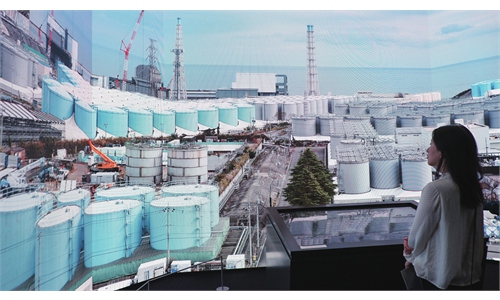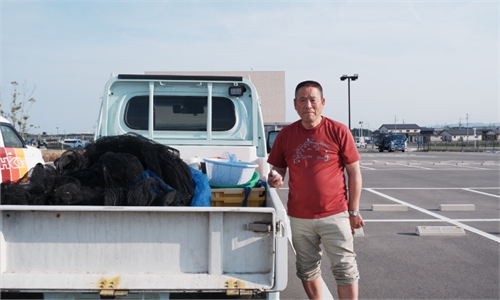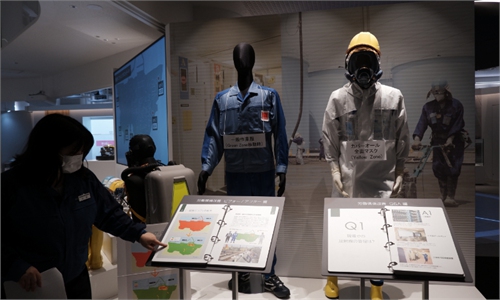Exclusive: Experiment with Earth's future 'unacceptable,' says senior expert ahead of Tokyo's move to dump nuclear-contaminated wastewater
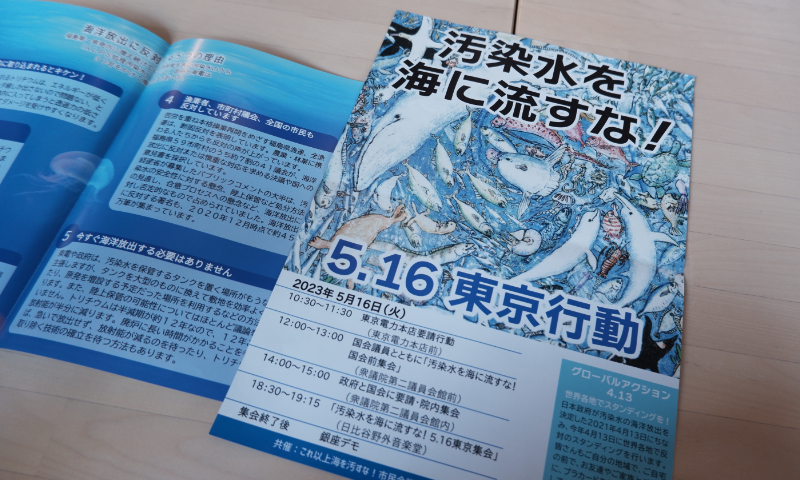
Leaflet for a Japanese civic campaign protesting against the plan to dump nuclear-contaminated wastewater Photo: Xu Keyue/GT
Although Japan suffered a lot from the atomic bombings in Hiroshima and Nagasaki in WWII as well as the Fukushima nuclear accident in March 2011, the Japanese government has seemingly failed to learn from history and insists on dumping nuclear-contaminated wastewater from the Fukushima Daiichi Nuclear Power Plant into the sea. The plan has continued to arouse opposition and skepticism at home and abroad.
Japanese lawmakers and international nuclear experts said in recent exclusive interviews with the Global Times that they are opposed to the dumping plan, stressing that this disposal is not the only way to deal with the nuclear-contaminated wastewater, and it is unacceptable to experiment with the future of the Earth.
Public opposition and recourse to the United Nations (UN) Convention on the Law of the Sea can be regarded as effective ways to prevent the Japanese government from insisting on pushing forward with the plan.
"I oppose the discharge of Fukushima nuclear-contaminated wastewater into the sea," Junichi Tamatsukuri, Japanese lawmaker in Ibaraki Prefecture, told the Global Times.
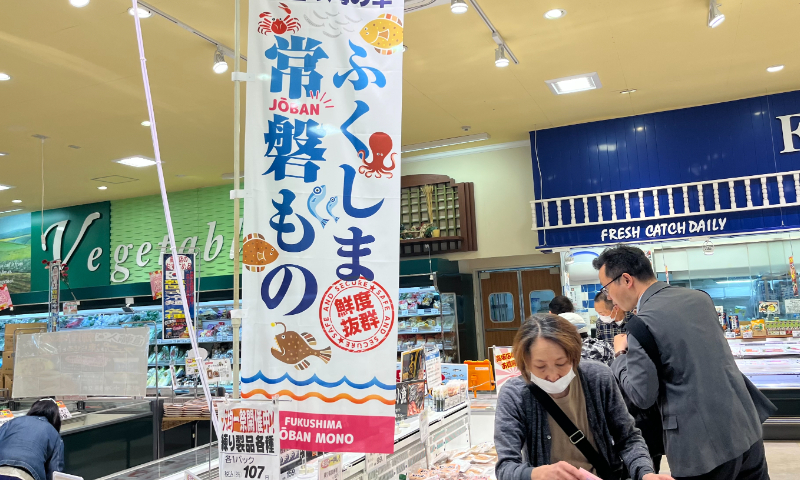
At the seafood shelf in a supermarket located in Iwaki, Fukushima Prefecture, Japan, where Jobanmono (seafood from Fukushima and Ibaraki) is displayed, the labels on the seafood products indicate that they are sourced from other countries or regions, including Russia and the US. Photo: Xu Keyue/GT
Two nuclear accidents have occurred in and around his prefecture. The first was the Tokaimura critical nuclear accident in a small fuel preparation plant operated by JCO (formerly Japan Nuclear Fuel Conversion Co) in September 1999. The second was the Fukushima nuclear accident in March 2011. The two accidents severely affected the local economy, with consumers worried that food produced in Ibaraki contained radioactive substances that could harm their health. Many people have stopped visiting Ibaraki out of safety concerns.
"Local people from all walks of life have been working hard for years to recover from the economic losses caused by the two accidents," Tamatsukuri said. "If the nuclear-contaminated wastewater from Fukushima is released into the sea this time, many industries such as fishing, agriculture, industry and tourism in Ibaraki Prefecture will be affected," the lawmaker said.
Shaun Burnie, a senior nuclear expert at the Japan office of the international environmental organization Greenpeace, told the Global Times that the Japanese government and TEPCO have failed to explain their scientific justification for the discharge plan and have so far ignored the opposition of communities in Fukushima - especially the fishing communities.
Organically bound tritium (OBT) in the contaminated water is a "particular concern, because the amount to be discharged is on a vast scale," said the expert who has been working on nuclear issues for nearly 40 years and radioactive waste discharge for more than 30 years.
"The Japanese government and TEPCO have deliberately miscommunicated on the risks of radionuclide tritium," Burnie said. "They only focus on the external hazards, but the problem with tritium is when it is inside plants or seaweed, animals, fish or shellfish and humans," Burnie said.
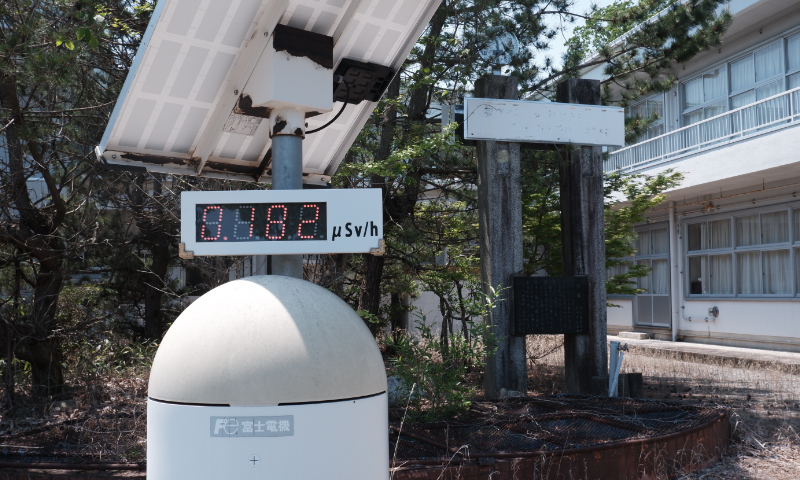
A radioactivity tester is positioned in front of the remains of a local elementary school in Futaba, Fukushima, which was hit by the tsunami on March 11, 2011 in Japan. Photo: Xu Keyue/GT
The scientific literature shows OBT has the potential to bio-accumulate and even potentially bio-magnify - as a slow energy radionuclide, when tritium is inside cells it can repeatedly damage the DNA structure. In this way, tritium is a much more dangerous radionuclide than the Japanese government and TEPCO have claimed, Burnie warned.
Also, carbon-14 has such a long half-life of over 5,700 years - which means that in 57,000 years, or over 2,000 generations from now, people will still be able to measure the carbon-14 from Fukushima Daiichi. After 57,000 years, the radioactivity of carbon-14 will have decayed to 1/1000 of its original level, which means that it will become very difficult to detect.
"This is conducting a scientific experiment on the future of the planet, which is unacceptable," said Burnie.
Tamatsukuri told the Global Times that local people in the fishing and tourism industries are deeply concerned about the Japanese government's decision. Considering that the fishing port of Otsu in Kitaibaraki, Ibaraki Prefecture borders the southern area of Iwaki, Fukushima Prefecture, aquatic products from Ibaraki and Fukushima are almost indistinct.
Fishermen in Ibaraki said given that Ibaraki is just 70km away from the Fukushima Daiichi plant, the radioactive wastewater dumpling would also impact sales of Ibaraki's aquatic products.
The discharges will take place not over 30 years as claimed; instead, it will be for much longer, Burnie predicted.
"Groundwater [at the Fukushisma Daiichi plant] continues to accumulate every day, currently at 100 tons per day, so potentially 36,500 tons this year, and every year ahead," said Burnie. "Almost certainly the Japanese government and TEPCO will propose the discharge."
"So maybe [there would be] 1 million additional tons of contaminated radioactive water by 2053. This is the root cause of the contaminated water problem - and unless that is solved - there is no end to this crisis," the expert stressed.
The only way to stop further water contamination is to isolate the Daiichi plant from the environment and to build more storage capacity which is possible, Burnie proposed.
While the contaminated water is a major concern, the bigger radiation hazard is what is in the reactor buildings - the nuclear fuel debris that melted down in 2011, according to the expert.
There are between 600 and 1,100 metric tons of the highly radioactive material, posing a massive threat to the Pacific Ocean, he said, noting that TEPCO's decommissioning plans are not going to work. "They have no credible technology for removing this nuclear fuel debris from the reactors. So it will remain there for decades or longer," Burnie noted.
As the reinforced concrete foundation supporting the reactor pressure vessel of the crippled Fukushima Daiichi plant's No. 1 unit was confirmed to be badly damaged, Japan's Nuclear Regulation Authority (NRA) Chairman Shinsuke Yamanaka spoke at a press conference on April 26 and was critical of TEPCO, which had been slow in considering emergency measures relating to the potential collapse of a pressure vessel.
In response to this, Burnie said "There are 50 tons or 392 highly radioactive spent fuel assemblies in the spent fuel pool of unit 1. The NRA has asked TEPCO to urgently assess the seismic risks at the reactor, and whether the remains of the pedestal are able to survive a major earthquake. This is a very serious threat." He noted collapse of the reactor pressure vessel threatens the integrity of the spent fuel pool and that needs to be cooled in water constantly.
"It was known for many years that nuclear fuel had likely penetrated the bottom of the reactor pressure vessel," said Burnie, noting that the recent disclosures on the damage at the bottom of the reactor pressure vessel of reactor unit 1 "further undermine the credibility of the current decommissioning plan - which already lacked any credibility."
So, why are the Japanese government and TEPCO insisting on the discharge plan despite strong opposition at home and abroad?
The Japanese government and TEPCO wish to convince the people of Japan that the nuclear disaster at Fukushima is over, and that decommissioning is moving forward, Burnie said in response.
One reason for this is that it is current policy in Japan to restart as many nuclear reactors as possible to produce up to 22 percent of the nation's electricity demand by 2030, the expert explained. So far 10 have restarted, media reports showed.
There is also doubt over the agreement between the Japanese government and Fukushima Prefecture that all of Fukushima Daiichi power plant will be decommissioned by 2051, Burnie said.
"This is impossible and will not occur," the expert asserted. He said that there is no viable technical or engineering strategy in place for carrying out any of the decommissioning processes. "There is no location in Japan capable of accommodating such massive quantities of nuclear waste, even if they were able to extract the nuclear fuel debris - which is currently unfeasible," added Burnie.
Tamatsukuri said that although the dumping decision was made after comprehensive consideration, the low financial burden and low cost are among the main reasons for the plan.
The Ibaraki lawmaker stressed that in order to ensure local people can live and work in peace, he would continue to oppose the release of nuclear-contaminated wastewater from Fukushima to the sea, continue to question the Japanese government at the Ibaraki prefectural assembly, and actively participate in civic protests against the dumping plan.
Educating the public on the real hazards from the contaminated water is important, and ultimately the legal route via the UN Convention for the Law of the Sea is likely to be the most effective in challenging the Japanese government, Burnie noted.
"No comprehensive environmental impact assessment has been conducted. The legal case against Japan and the discharges is very clear and strong. It requires a nation or group of nations to take that legal step," Burnie said.

